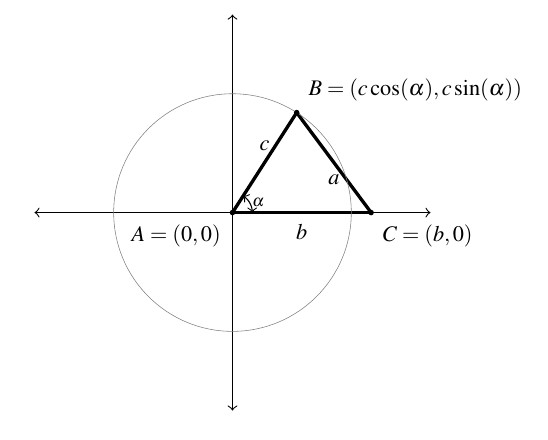8.5 Law of Cosines
In Section 8.4, we developed the Law of Sines (Theorem 8.15) to enable us to solve triangles in the `Angle-Angle-Side’ (AAS), the `Angle-Side-Angle’ (ASA) and the ambiguous `Side-Side-Angle’ (SSA) cases.
In this section, we develop the Law of Cosines which handles solving triangles in the `Side-Angle-Side’ (SAS) and `Side-Side-Side’ (SSS) cases.[1] We state and prove the theorem below.
Theorem 8.18 Law of Cosines
Given a triangle with angle-side opposite pairs ![]() ,
, ![]() and
and ![]() , the following equations hold
, the following equations hold
or, solving for the cosine in each equation, we have
To prove the theorem, we consider a generic triangle with the vertex of angle ![]() at the origin with side
at the origin with side ![]() positioned along the positive
positioned along the positive ![]() -axis as sketched in the diagram below.
-axis as sketched in the diagram below.

From this set-up, we immediately find that the coordinates of ![]() and
and ![]() are
are ![]() and
and ![]() . From Theorem 7.4, we know that because the point
. From Theorem 7.4, we know that because the point ![]() lies on a circle of radius
lies on a circle of radius ![]() , the coordinates of
, the coordinates of ![]() are
are ![]() . (This would be true even if
. (This would be true even if ![]() were an obtuse or right angle so although we have drawn the case when
were an obtuse or right angle so although we have drawn the case when ![]() is acute, the following computations hold for any angle
is acute, the following computations hold for any angle ![]() drawn in standard position where
drawn in standard position where ![]() .)
.)
We note that the distance between the points ![]() and
and ![]() is none other than the length of side
is none other than the length of side ![]() . Using the distance formula, Equation 1.1, we get
. Using the distance formula, Equation 1.1, we get
![Rendered by QuickLaTeX.com \[\begin{array}{rclr} a & = & \sqrt{(c \cos(\alpha) - b)^{2} + (c \sin(\alpha) - 0)^2} & \\ [3pt] a^{2} & = & \left(\sqrt{(c \cos(\alpha) - b)^{2} + c^2 \sin^2(\alpha)}\right)^2 & \\ [3pt] a^2 & = & (c \cos(\alpha) - b)^{2} + c^2 \sin^2(\alpha) & \\ [3pt] a^2 & = & c^2 \cos^2(\alpha) - 2bc \cos(\alpha) + b^2 + c^2 \sin^2(\alpha) & \\ [3pt] a^2 & = & c^2\left(\cos^2(\alpha) + \sin^2(\alpha)\right) + b^2 - 2bc \cos(\alpha) & \\ [3pt] a^2 & = & c^2(1) + b^2 - 2bc \cos(\alpha) & \text{As $\cos^2(\alpha) + \sin^2(\alpha) = 1$}\\ [3pt] a^2 & = & c^2 + b^2 - 2bc \cos(\alpha) & \\ \end{array} \]](https://pressbooks.library.tamu.edu/app/uploads/quicklatex/quicklatex.com-64be2c340ac88c41fa02bdd9a00b126b_l3.png)
The remaining formulas given in Theorem 8.18 can be shown by simply reorienting the triangle to place a different vertex at the origin. We leave these details to the reader.
What’s important about ![]() and
and ![]() in the above proof is that
in the above proof is that ![]() is an angle-side opposite pair and
is an angle-side opposite pair and ![]() and
and ![]() are the sides adjacent to
are the sides adjacent to ![]() — the same can be said of any other angle-side opposite pair in the triangle.
— the same can be said of any other angle-side opposite pair in the triangle.
Notice that the proof of the Law of Cosines relies on the distance formula which has its roots in the Pythagorean Theorem. That being said, the Law of Cosines can be thought of as a generalization of the Pythagorean Theorem.
Indeed, in a triangle in which ![]() , (i.e., a right triangle) then
, (i.e., a right triangle) then ![]() and we get the familiar relationship
and we get the familiar relationship ![]() . What this means is that in the larger mathematical sense, the Law of Cosines and the Pythagorean Theorem amount to pretty much the same thing.[2]
. What this means is that in the larger mathematical sense, the Law of Cosines and the Pythagorean Theorem amount to pretty much the same thing.[2]
Example 8.5.1
Example 8.5.1.1
Solve the following triangles. Give exact answers and decimal approximations (rounded to hundredths) and sketch the triangle.
![]() ,
, ![]() units,
units, ![]() units
units
Solution:
Solve the triangle with the properties: ![]() ,
, ![]() units,
units, ![]() units. Give exact answers and decimal approximations (rounded to hundredths) and sketch the triangle.
units. Give exact answers and decimal approximations (rounded to hundredths) and sketch the triangle.
We are given the lengths of two sides, ![]() and
and ![]() , and the measure of the included angle,
, and the measure of the included angle, ![]() .
.
With no angle-side opposite pair to use for the Law of Sines, we apply the Law of Cosines. We get
![Rendered by QuickLaTeX.com \[ \begin{array}{rcl} b^2 &=& 7^2 + 2^2 - 2(7)(2)\cos\left(50^{\circ}\right) \\[4pt] b &=& \sqrt{53-28\cos\left(50^{\circ}\right)} \\[4pt] & \approx & 5.92 \text{ units} \end{array}\]](https://pressbooks.library.tamu.edu/app/uploads/quicklatex/quicklatex.com-4623ca0c7547bdde62402fb3ad2101d1_l3.png)
In order to determine the measures of the remaining angles ![]() and
and ![]() , we are forced to used the derived value for
, we are forced to used the derived value for ![]() . There are two ways to proceed at this point. We could use the Law of Cosines again, or, now that we have the angle-side opposite pair
. There are two ways to proceed at this point. We could use the Law of Cosines again, or, now that we have the angle-side opposite pair ![]() we could use the Law of Sines.
we could use the Law of Sines.
The advantage to using the Law of Cosines over the Law of Sines in cases like this is that unlike the sine function, the cosine function distinguishes between acute and obtuse angles. The cosine of an acute is positive, whereas the cosine of an obtuse angle is negative. The sine of both acute and obtuse angles are positive, thus the sine of an angle alone is not enough to determine if the angle in question is acute or obtuse.
As both authors of the textbook prefer the Law of Cosines, we proceed with this method first. When using the Law of Cosines, it’s always best to find the measure of the largest unknown angle first, as this will give us the obtuse angle of the triangle, if there is one.
The largest angle is opposite the longest side, so we choose to find ![]() first. To that end, we use the formula
first. To that end, we use the formula ![]() and substitute
and substitute ![]() ,
, ![]() and
and ![]() . We get[3]
. We get[3]
![]()
Because ![]() is an angle in a triangle, we know the radian measure of
is an angle in a triangle, we know the radian measure of ![]() must lie between
must lie between ![]() and
and ![]() radians. This matches the range of the arccosine function, so we have
radians. This matches the range of the arccosine function, so we have
![Rendered by QuickLaTeX.com \[\alpha = \arccos\left(\frac{2-7\cos\left(50^{\circ}\right)}{\sqrt{53-28\cos\left(50^{\circ} \right)}}\right) \, \text{radians} \, \approx 114.99^{\circ}\]](https://pressbooks.library.tamu.edu/app/uploads/quicklatex/quicklatex.com-ae923eea4894f8920465c486fe2ba3ce_l3.png)
At this point, we could find ![]() using
using
![Rendered by QuickLaTeX.com \[ \begin{array}{rcl} \gamma &=& 180^{\circ} - \alpha - \beta \\[4pt] &\approx & 180^{\circ} - 114.99^{\circ} - 50^{\circ} \\[4pt] &=& 15.01^{\circ} \end{array} \]](https://pressbooks.library.tamu.edu/app/uploads/quicklatex/quicklatex.com-cc66a01471e2774fdbfdd64f97a5eece_l3.png)
that is if we trust our approximation for ![]() .
.
To minimize propagation of error (and obtain an exact answer for ![]() ), however, we could use the Law of Cosines again.[4] From
), however, we could use the Law of Cosines again.[4] From ![]() with
with ![]() ,
, ![]() and
and ![]() , we get
, we get
![Rendered by QuickLaTeX.com \[ \begin{array}{rcl} \gamma &=& \arccos\left(\frac{7-2 \cos\left(50^{\circ}\right)}{\sqrt{53-28\cos\left(50^{\circ} \right)}} \right) \text{ radians } \\[10pt] & \approx & 15.01^{\circ} \end{array} \]](https://pressbooks.library.tamu.edu/app/uploads/quicklatex/quicklatex.com-d4d4860d05c76c1205e77bd76463a023_l3.png)
We sketch the triangle below.

As we mentioned earlier, once we’ve determined ![]() it is possible to use the Law of Sines to find the remaining angles. Here, however, we must proceed with caution as we are in the ambiguous (SSA) case. In the ambiguous case it is advisable to first find the smallest of the unknown angles, because we are guaranteed it will be acute.[5]
it is possible to use the Law of Sines to find the remaining angles. Here, however, we must proceed with caution as we are in the ambiguous (SSA) case. In the ambiguous case it is advisable to first find the smallest of the unknown angles, because we are guaranteed it will be acute.[5]
In this case, we would find ![]() as the side opposite
as the side opposite ![]() is smaller than the side opposite the other unknown angle,
is smaller than the side opposite the other unknown angle, ![]() . Using the angle-side opposite pair
. Using the angle-side opposite pair ![]() , we get
, we get ![]() . The usual calculations produces
. The usual calculations produces ![]() and
and ![]() .
.
Example 8.5.1.2
Solve the following triangles. Give exact answers and decimal approximations (rounded to hundredths) and sketch the triangle.
![]() units,
units, ![]() units,
units, ![]() units
units
Solution:
Solve the triangle with the properties: ![]() units,
units, ![]() units,
units, ![]() units. Give exact answers and decimal approximations (rounded to hundredths) and sketch the triangle.
units. Give exact answers and decimal approximations (rounded to hundredths) and sketch the triangle.
All three sides and no angles are given, so we are forced to use the Law of Cosines. Following our discussion in the previous problem, we find ![]() first, as it is opposite the longest side,
first, as it is opposite the longest side, ![]() . We get
. We get
![Rendered by QuickLaTeX.com \[ \begin{array}{rcl} \cos(\beta) &=& \frac{a^2+c^2-b^2}{2ac}\\[10pt] &=& -\frac{1}{5} \\[4pt] \beta &=& \arccos\left(-\frac{1}{5}\right) \text{ radians } \\[4pt] &\approx& 101.54^{\circ} \end{array} \]](https://pressbooks.library.tamu.edu/app/uploads/quicklatex/quicklatex.com-ec329b3b54646264ca55509fb36e0f4e_l3.png)
Now that we have obtained an angle-side opposite pair ![]() , we could proceed using the Law of Sines. The Law of Cosines, however, offers us a rare opportunity to find the remaining angles using only the data given to us in the statement of the problem.
, we could proceed using the Law of Sines. The Law of Cosines, however, offers us a rare opportunity to find the remaining angles using only the data given to us in the statement of the problem.
Using the Law of Cosines, we get
![]()
and
![]()
We sketch this triangle below.

We note that, depending on how many decimal places are carried through successive calculations, and depending on which approach is used to solve the problem, the approximate answers you obtain may differ slightly from those the authors obtain in the Examples and the Exercises.
A great example of this is number 2 in Example 8.5.1, where the approximate values we record for the measures of the angles sum to ![]() , which is geometrically impossible.
, which is geometrically impossible.
Example 8.5.2
Example 8.5.2
A researcher wishes to determine the width of a vernal pond as drawn below. From a point ![]() , he finds the distance to the eastern-most point of the pond to be
, he finds the distance to the eastern-most point of the pond to be ![]() feet, while the distance to the western-most point of the pond from
feet, while the distance to the western-most point of the pond from ![]() is
is ![]() feet. If the angle between the two lines of sight is
feet. If the angle between the two lines of sight is ![]() , find the width of the pond.
, find the width of the pond.

Solution:
We are given the lengths of two sides and the measure of an included angle, so we may apply the Law of Cosines to find the length of the missing side opposite the given angle.
Calling this length ![]() (for width), we get
(for width), we get
![Rendered by QuickLaTeX.com \[ \begin{array}{rcl} w^2 &=& 950^2 + 1000^2 - 2(950)(1000)\cos\left(60^{\circ}\right) \\[4pt] &=& 952500\\[4pt] w &=& \sqrt{952500}\\[4pt] &\approx& 976 \text{ feet} \end{array} \]](https://pressbooks.library.tamu.edu/app/uploads/quicklatex/quicklatex.com-907e9f67ac845090ffa2628720ede9f5_l3.png)
In Section 8.4, we used the proof of the Law of Sines to develop Theorem 8.17 as an alternate formula for the area enclosed by a triangle. In this section, we use the Law of Cosines to derive another such formula, the so-called Heron’s Formula.[6]
Theorem 8.19 Heron’s Formula
Suppose ![]() ,
, ![]() and
and ![]() denote the lengths of the three sides of a triangle. Let
denote the lengths of the three sides of a triangle. Let ![]() be the semiperimeter of the triangle, that is, let
be the semiperimeter of the triangle, that is, let ![]() . Then, the area
. Then, the area ![]() enclosed by the triangle is given by
enclosed by the triangle is given by
![]()
We prove Theorem 8.19 using Theorem 8.17. Using the convention that the angle ![]() is opposite the side
is opposite the side ![]() , we have
, we have ![]() from Theorem 8.17.
from Theorem 8.17.
In order to simplify computations, we start by manipulating the expression for ![]() .
.
![Rendered by QuickLaTeX.com \[ \begin{array}{rclr} A^2 & = & \left(\dfrac{1}{2} ab \sin(\gamma)\right)^2 &\\[10pt] & = & \dfrac{1}{4} a^2 b^2 \sin^{2}(\gamma) & \\[10pt] & = & \dfrac{a^2b^2}{4} \left(1 - \cos^{2}(\gamma)\right) & \text{as $\sin^2(\gamma) = 1 - \cos^{2}(\gamma)$.} \\ \end{array}\]](https://pressbooks.library.tamu.edu/app/uploads/quicklatex/quicklatex.com-55173995726ba9114bf9603ff41135ed_l3.png)
The Law of Cosines tells us ![]() , so substituting this into our equation for
, so substituting this into our equation for ![]() gives
gives
![Rendered by QuickLaTeX.com \[ \begin{array}{rclr} A^2 & = & \dfrac{a^2b^2}{4} \left(1 - \cos^{2}(\gamma)\right) & \text{\hphantom{perfect square trinomials.}}\\[10pt] & = & \dfrac{a^2b^2}{4} \left[1 - \left( \dfrac{a^2 + b^2 - c^2}{2ab} \right)^2\right] & \\ [10pt] & = & \dfrac{a^2b^2}{4} \left[1 - \dfrac{\left(a^2 + b^2 - c^2\right)^2}{4a^2b^2} \right] & \\ [10pt] & = & \dfrac{a^2b^2}{4} \left[\dfrac{4a^2 b^2 - \left(a^2 + b^2 - c^2\right)^2}{4a^2b^2} \right] & \\ [10pt] & = & \dfrac{4a^2 b^2 - \left(a^2 + b^2 - c^2\right)^2}{16} & \\ \end{array} \]](https://pressbooks.library.tamu.edu/app/uploads/quicklatex/quicklatex.com-1181801d0a458fd6baf37c8ece609761_l3.png)
Recognizing ![]() as a perfect square,
as a perfect square, ![]() , we can factor the resulting difference of squares:
, we can factor the resulting difference of squares:
![Rendered by QuickLaTeX.com \[ \begin{array}{rclr} A^2 & = & \dfrac{(2ab)^2 - \left(a^2 + b^2 - c^2\right)^2}{16} & \\ [10pt] & = & \dfrac{\left( 2ab - \left[a^2+b^2 - c^2\right]\right) \left( 2ab + \left[a^2+b^2 - c^2\right]\right)}{16} & \text{difference of squares.} \\ [10pt] & = & \dfrac{\left(c^2 - a^2 + 2ab - b^2 \right)\left( a^2 + 2ab + b^2- c^2\right)}{16} & \\ [10pt] \end{array} \]](https://pressbooks.library.tamu.edu/app/uploads/quicklatex/quicklatex.com-d29bfb4cc178e5ff1fb7bc8c1a59be05_l3.png)
Next, we regroup ![]() and
and ![]() . Recognizing
. Recognizing ![]() and
and ![]() , we continue factoring:
, we continue factoring:
![Rendered by QuickLaTeX.com \[ \begin{array}{rclr} A^2 & = & \dfrac{\left(c^2 - \left[a^2 - 2ab + b^2\right] \right) \left( \left[a^2 + 2ab + b^2\right]- c^2\right)}{16} & \\ [10pt] & = & \dfrac{\left(c^2 - (a-b)^2 \right) \left( (a+b)^2- c^2\right)}{16} & \text{perfect square trinomials.}\\ [10pt] & = & \dfrac{ (c-(a-b))(c+(a-b))((a+b) -c)((a+b)+c)}{16} & \text{difference of squares.} \\ [10pt] & = & \dfrac{ (b+c-a)(a+c-b)(a+b-c)(a+b+c)}{16} & \\ [10pt] & = & \dfrac{(b+c-a)}{2} \cdot \dfrac{(a+c-b)}{2} \cdot \dfrac{(a+b-c)}{2} \cdot \dfrac{(a+b+c)}{2} & \\ [10pt] \end{array} \]](https://pressbooks.library.tamu.edu/app/uploads/quicklatex/quicklatex.com-a225a72af7e9e5ab009fcfa8f3aee9c2_l3.png)
At this stage, we recognize the last factor as the semiperimeter, ![]() . To complete the proof, we note that
. To complete the proof, we note that
![Rendered by QuickLaTeX.com \[ \begin{array}{rcl} (s - a) &=& \dfrac{a+b+c}{2} - a \\[4pt] &=& \dfrac{a+b+c-2a}{2}\\[4pt] &=& \dfrac{b+c-a}{2} \end{array} \]](https://pressbooks.library.tamu.edu/app/uploads/quicklatex/quicklatex.com-b097d9ae062eb1e2bc295705c96c3287_l3.png)
Similarly, we find ![]() and
and ![]() . Hence, we get
. Hence, we get
![Rendered by QuickLaTeX.com \[ \begin{array}{rclr} A^2 & = & \dfrac{(b+c-a)}{2} \cdot \dfrac{(a+c-b)}{2} \cdot \dfrac{(a+b-c)}{2} \cdot \dfrac{(a+b+c)}{2} & \\ [10pt] & = & (s-a) (s-b) (s-c) s & \\ [10pt] \end{array} \]](https://pressbooks.library.tamu.edu/app/uploads/quicklatex/quicklatex.com-42fbe84eb41759c8c54c6db1b540e1bb_l3.png)
so that ![]() as required.
as required.
We close with an example of Heron’s Formula.
Example 8.5.3
Example 8.5.3
Compute the area enclosed of the triangle in Example 8.5.1 number 2.
Solution:
We are given ![]() ,
, ![]() and
and ![]() . Using these values, we find
. Using these values, we find
![]()
so
![Rendered by QuickLaTeX.com \[ \begin{array}{rcl} (s - a) &=& 8 - 4 = 4, \\[4pt] (s-b) &=& 8-7 =1, \text{ and} \\[4pt] (s-c) &=& 8-5=3 \end{array} \]](https://pressbooks.library.tamu.edu/app/uploads/quicklatex/quicklatex.com-80e55b739aa3ab5c403b23bff770e15d_l3.png)
Per Heron’s Formula,
![Rendered by QuickLaTeX.com \[ \begin{array}{rcl} A &=& \sqrt{s(s-a)(s-b)(s-c)} \\ &=& \sqrt{(8)(4)(1)(3)}\\ &=& \sqrt{96}\\ &=& 4\sqrt{6} \\ &\approx & 9.80 \text{ square units} \end{array} \]](https://pressbooks.library.tamu.edu/app/uploads/quicklatex/quicklatex.com-d7d4ad91192b39af3442d5192238af13_l3.png)
8.5.1 Section Exercises
In Exercises 1 – 10, use the Law of Cosines to compute the remaining side(s) and angle(s) if possible.
In Exercises 11 – 16, use any method to solve for the remaining side(s) and angle(s), if possible.






- Determine the area of the triangles given in Exercises 6, 8 and 10 above.
- The hour hand on my antique Seth Thomas schoolhouse clock in 4 inches long and the minute hand is 5.5 inches long. Find the distance between the ends of the hands when the clock reads four o’clock. Round your answer to the nearest hundredth of an inch.
- A geologist wants to measure the diameter of an impact crater. From her camp, it is 4 miles to the northern-most point of the crater and 2 miles to the southern-most point. If the angle between the two lines of sight is
 , what is the diameter of the crater? Round your answer to the nearest hundredth of a mile.
, what is the diameter of the crater? Round your answer to the nearest hundredth of a mile. - From the Pedimaxus International Airport a tour helicopter can fly to Cliffs of Insanity Point by following a bearing of N
 E for 192 miles and it can fly to Bigfoot Falls by following a bearing of S
E for 192 miles and it can fly to Bigfoot Falls by following a bearing of S E for 207 miles.[7] Find the distance between Cliffs of Insanity Point and Bigfoot Falls. Round your answer to the nearest mile.
E for 207 miles.[7] Find the distance between Cliffs of Insanity Point and Bigfoot Falls. Round your answer to the nearest mile. - Cliffs of Insanity Point and Bigfoot Falls from Exercise 20 above both lie on a straight stretch of the Great Sasquatch Canyon. What bearing would the tour helicopter need to follow to go directly from Bigfoot Falls to Cliffs of Insanity Point? Round your angle to the nearest tenth of a degree.
- A naturalist sets off on a hike from a lodge on a bearing of S
 W. After 1.5 miles, she changes her bearing to S
W. After 1.5 miles, she changes her bearing to S W and continues hiking for 3 miles. Find her distance from the lodge at this point. Round your answer to the nearest hundredth of a mile. What bearing should she follow to return to the lodge? Round your angle to the nearest degree.
W and continues hiking for 3 miles. Find her distance from the lodge at this point. Round your answer to the nearest hundredth of a mile. What bearing should she follow to return to the lodge? Round your angle to the nearest degree. - The HMS Sasquatch leaves port on a bearing of N
 E and travels for 5 miles. It then changes course and follows a heading of S
E and travels for 5 miles. It then changes course and follows a heading of S E for 2 miles. How far is it from port? Round your answer to the nearest hundredth of a mile. What is its bearing to port? Round your angle to the nearest degree.
E for 2 miles. How far is it from port? Round your answer to the nearest hundredth of a mile. What is its bearing to port? Round your angle to the nearest degree. - The SS Bigfoot leaves a harbor bound for Nessie Island which is 300 miles away at a bearing of N
 E. A storm moves in and after 100 miles, the captain of the Bigfoot finds he has drifted off course. If his bearing to the harbor is now S
E. A storm moves in and after 100 miles, the captain of the Bigfoot finds he has drifted off course. If his bearing to the harbor is now S W, how far is the SS Bigfoot from Nessie Island? Round your answer to the nearest hundredth of a mile. What course should the captain set to head to the island? Round your angle to the nearest tenth of a degree.
W, how far is the SS Bigfoot from Nessie Island? Round your answer to the nearest hundredth of a mile. What course should the captain set to head to the island? Round your angle to the nearest tenth of a degree. - From a point 300 feet above level ground in a firetower, a ranger spots two fires in the Yeti National Forest. The angle of depression[8] made by the line of sight from the ranger to the first fire is
 and the angle of depression made by line of sight from the ranger to the second fire is
and the angle of depression made by line of sight from the ranger to the second fire is  . The angle formed by the two lines of sight is
. The angle formed by the two lines of sight is  . Find the distance between the two fires. Round your answer to the nearest foot.
. Find the distance between the two fires. Round your answer to the nearest foot.

HINT: In order to use the
 angle between the lines of sight, you will first need to use right angle Trigonometry to find the lengths of the lines of sight. This will give you a Side-Angle-Side case in which to apply the Law of Cosines.
angle between the lines of sight, you will first need to use right angle Trigonometry to find the lengths of the lines of sight. This will give you a Side-Angle-Side case in which to apply the Law of Cosines. - If you apply the Law of Cosines to the ambiguous Angle-Side-Side (ASS) case, the result is a quadratic equation whose variable is that of the missing side. If the equation has no positive real zeros then the information given does not yield a triangle. If the equation has only one positive real zero then exactly one triangle is formed and if the equation has two distinct positive real zeros then two distinct triangles are formed. Apply the Law of Cosines to Exercises 11, 13, and 14 above in order to demonstrate this result.
Section 8.5 Exercise Answers can be found in the Appendix … Coming soon
- Here, `Side-Angle-Side' means that we are given two sides and the `included' angle - that is, the given angle is adjacent to both of the given sides. ↵
- This shouldn't come as too much of a shock. All of the theorems in Trigonometry can ultimately be traced back to the definition of the circular functions along with the distance formula and hence, the Pythagorean Theorem. ↵
- after simplifying
 ↵
↵ - Your instructor will let you know which procedure to use. It all boils down to how much you trust your calculator. ↵
- There can only be one obtuse angle in the triangle, and if there is one, it must be the largest. ↵
- Or `Hero's Formula.' ↵
- Please refer to Section 8.4.1 for an introduction to bearings. ↵
- See Exercise 18 in Section 7.2.1 for the definition of this angle. ↵

